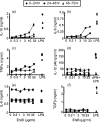Modulation of human monocytes by Escherichia coli heat-labile enterotoxin B-subunit; altered cytokine production and its functional consequences
- PMID: 12100719
- PMCID: PMC1782726
- DOI: 10.1046/j.1365-2567.2002.01429.x
Modulation of human monocytes by Escherichia coli heat-labile enterotoxin B-subunit; altered cytokine production and its functional consequences
Abstract
In murine systems, the B subunit of Escherichia coli heat-labile enterotoxin (EtxB) is a potent immunomodulator capable of suppressing Th1-mediated autoimmune diseases. This results from its ability to bind cell surface receptors, principally GM1-ganglioside, and as a consequence down-regulate the pathological T helper type 1 (Th1) response. The capacity of EtxB to alter human T-cell responses has not been investigated. Here we show that EtxB, but not the receptor non-binding mutant EtxB (G33D), triggers the release of interleukin (IL)-10, IL-6 and tumour necrosis factor-alpha (TNF-alpha) by human monocytes. The production of IL-8, transforming growth factor-beta (TGF-beta) or IL-12 was not enhanced by EtxB. Indeed, EtxB was shown to inhibit IL-12 secretion in monocytes stimulated with interferon-gamma (IFN-gamma) and lipopolysaccharide (LPS) by an IL-10-independent mechanism. When EtxB-treated monocytes were used as antigen presenting cells in an allogeneic mixed lymphocyte reaction (MLR), IL-10 and IFN-gamma production were increased in comparison to levels seen in cultures stimulated with untreated monocytes; proliferation was unaltered. This modulation of the T-cell response was not only evident in the primary MLR triggered by EtxB-treated monocytes, but also upon restimulation of the responding T cells with fresh untreated monocytes; indicating that presentation by EtxB-treated monocytes leads to altered T-cell differentiation. Sorting experiments showed that IL-10 secreting T cells from the MLR cultures were strong suppressors of T-cell proliferation following their addition into a fresh primary MLR.
Figures





Similar articles
-
Potent immunogenicity of the B subunits of Escherichia coli heat-labile enterotoxin: receptor binding is essential and induces differential modulation of lymphocyte subsets.Proc Natl Acad Sci U S A. 1996 Jan 9;93(1):226-30. doi: 10.1073/pnas.93.1.226. Proc Natl Acad Sci U S A. 1996. PMID: 8552610 Free PMC article.
-
Modulation of B-cell activation by the B subunit of Escherichia coli enterotoxin: receptor interaction up-regulates MHC class II, B7, CD40, CD25 and ICAM-1.Immunology. 1997 Aug;91(4):572-8. doi: 10.1046/j.1365-2567.1997.00291.x. Immunology. 1997. PMID: 9378497 Free PMC article.
-
The B subunit of Escherichia coli heat-labile enterotoxin inhibits Th1 but not Th17 cell responses in established experimental autoimmune uveoretinitis.Invest Ophthalmol Vis Sci. 2008 Sep;49(9):4008-17. doi: 10.1167/iovs.08-1848. Epub 2008 May 9. Invest Ophthalmol Vis Sci. 2008. PMID: 18469197
-
Cross-linking of cell surface ganglioside GM1 induces the selective apoptosis of mature CD8+ T lymphocytes.Int Immunol. 1996 May;8(5):731-6. doi: 10.1093/intimm/8.5.731. Int Immunol. 1996. PMID: 8671661 Review.
-
Immune modulation by the cholera-like enterotoxin B-subunits: from adjuvant to immunotherapeutic.Int J Med Microbiol. 2000 Oct;290(4-5):447-53. doi: 10.1016/S1438-4221(00)80062-4. Int J Med Microbiol. 2000. PMID: 11111925 Review.
Cited by
-
Protection of non-obese diabetic mice from autoimmune diabetes by Escherichia coli heat-labile enterotoxin B subunit.Immunology. 2006 Feb;117(2):262-70. doi: 10.1111/j.1365-2567.2005.02294.x. Immunology. 2006. PMID: 16423062 Free PMC article.
-
Innate-immunity cytokines induced by very small size proteoliposomes, a Neisseria-derived immunological adjuvant.Clin Exp Immunol. 2007 Feb;147(2):379-88. doi: 10.1111/j.1365-2249.2006.03297.x. Clin Exp Immunol. 2007. PMID: 17223981 Free PMC article.
-
Human monocytes accelerate proliferation and blunt differentiation of preadipocytes in association with suppression of C/EBPΑ mRNA.Obesity (Silver Spring). 2012 Feb;20(2):253-62. doi: 10.1038/oby.2011.275. Epub 2011 Aug 25. Obesity (Silver Spring). 2012. PMID: 21869759 Free PMC article.
-
Orally administered recombinant Lactobacillus expressing African swine fever virus antigens that induced immunity responses.Front Microbiol. 2023 Jan 9;13:1103327. doi: 10.3389/fmicb.2022.1103327. eCollection 2022. Front Microbiol. 2023. PMID: 36699597 Free PMC article.
-
The B subunit of Escherichia coli heat-labile enterotoxin induces both caspase-dependent and -independent cell death pathways in CD8+ T cells.Infect Immun. 2004 Oct;72(10):5850-7. doi: 10.1128/IAI.72.10.5850-5857.2004. Infect Immun. 2004. PMID: 15385486 Free PMC article.
References
-
- Finkelstein RA, Norris HT, Dutta NK. Pathogenesis of experimental cholera in infant rabbits. 1. Observations on the intraintestinal infection and experimental cholera produced with cell free products. J Infect Dis. 1964;114:203–16. - PubMed
-
- Elson CO, Ealding W. Generalised systemic and mucosal immunity in mice after mucosal stimulation with cholera toxin. J Immunol. 1984;132:2736–41. - PubMed
-
- Clements JD, Hartzog NM, Lyons FL. Adjuvant activity of Escherichia coli heat-labile enterotoxin and effect on the induction or oral tolerance in mice to unrelated protein antigens. Vaccine. 1988;6:269–77. - PubMed
Publication types
MeSH terms
Substances
LinkOut - more resources
Full Text Sources
Other Literature Sources

